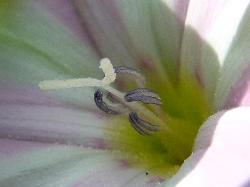- Taxon
- Gallery
Rhizomatous perennial with slender, creeping or trailing, angular, usually hairy stems. Petioles 5–20–(35) mm long. Lamina (0.8)–2–4–(9) × (0.5)–1–2–(6) cm, triangular or oblong-ovate (very rarely linear), hastate or sagittate, entire, except often for pair of teeth near base, usually glabrous or sparsely hairy, rarely moderately hairy, often glaucous; sinus shallow or base ± truncate; apex rounded and mucronulate. Infl. axillary, 1-few-flowered; peduncles often = or slightly > lvs; pedicels slender, glabrous. Bracts 2–4 mm long, linear, hairy, situated > 1 cm below calyx. Sepals c. 4 mm long, obtuse, the outer ciliate and often hairy, subequal. Corolla (1.2)–1.5–2 cm long, broadly funnelform, pink or whitish, with deep pink mid-petaline bands, very rarely completely white. Stamens subequal; filaments widened and puberulent towards base. Stigmas filiform, much < style. Capsule 6–8 mm long, globose-ovoid. Seed dark, smooth.
[From: Webb et al. (1988) Flora of New Zealand. Volume 4.]
Flowering: Nov.–Mar.




